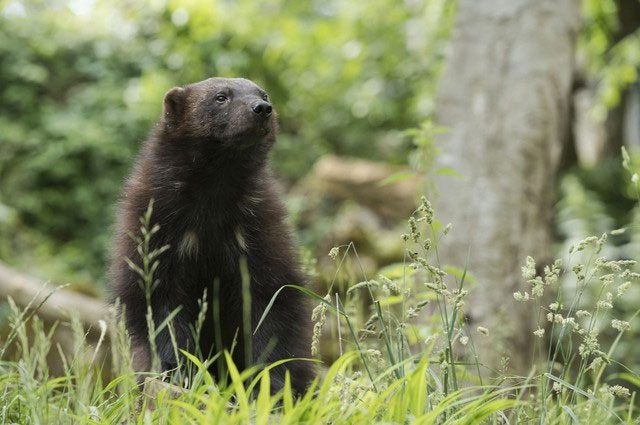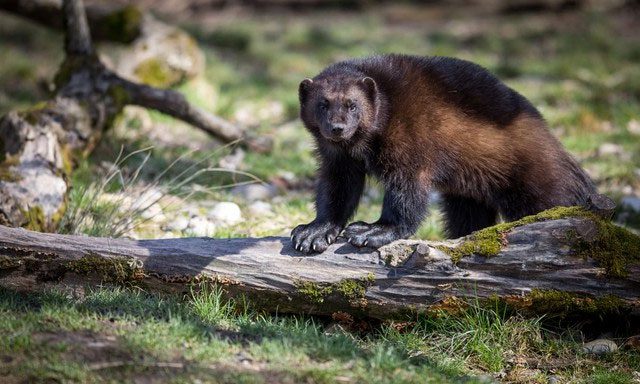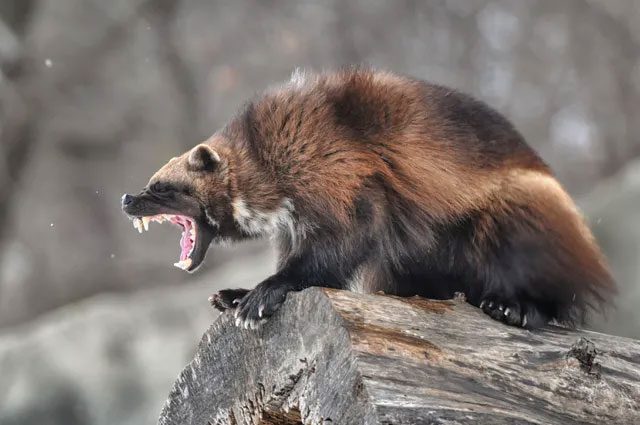Despite their physical differences, this animal possesses qualities that earn it the title of “wolverine,” particularly its aggressive nature combined with a muscular build, making it unafraid to confront wolves, black bears, and even polar bears.
In English, the species wolverine is referred to by the name “Wolverines”, which is also the name given to the famous superhero “Wolverine” in the “X-Men” film series. Wolverines primarily inhabit the frigid Northern regions, including the Northern Taiga forests, sub-Arctic areas, northern Canada, Northern Europe, Siberia, and the state of Alaska.

Anatomically, wolverines resemble a mini bear, with short legs, a broad and round head, small eyes, and short round ears. When fully grown, wolverines can reach a length of 65-107 cm (excluding the tail) and weigh around 9-25 kg. They have a thick black fur coat that contains water-repellent oil, providing them with protection against frost and the biting cold of the Northern regions. They primarily live in sub-Arctic coniferous forests and tundra grasslands, mainly distributed in the northern part of the Greater Khingan mountain range and the Altai region of China, and have a very wide range of activity. In winter, they particularly enjoy moving around the forest edges.

Although they look quite different from our imagination of a “werewolf,” wolverines still possess qualities that truly justify this name. First and foremost is their physical strength. This animal has a robust and muscular physique, which provides them with astonishing strength relative to their body size. Additionally, wolverines are equipped with formidable weapons, the most impressive being their sharp claws and powerful jaws capable of tearing through frozen meat.

Another notable characteristic of wolverines is their extremely aggressive nature. Combined with their superior physique mentioned above, wolverines are virtually unafraid of any animal in their habitat. In fact, they can confront other notorious predators much larger than themselves, such as gray wolves, black bears, and even polar bears, with many reports indicating that wolverines have triumphed in these survival battles.

Generally, an animal weighing more than 30 kg would never provoke larger beasts like gray wolves and brown bears. However, the wolverine is not an ordinary animal. It has been observed more than once snatching food from the mouths of gray wolves and brown bears, and in most cases, the wolverine escapes unscathed.

The main prey of wolverines includes mammals such as hedgehogs, squirrels, beavers, rabbits, gophers, and mice. They can even take down larger animals like reindeer and deer. Occasionally, these animals also hunt other carnivores like minks, otters, lynxes, prairie wolves, and wolf pups. In the cold winter, the primary food source for wolverines comes from carrion. Sometimes, they also supplement their diet with bird eggs, roots, tree seeds, larvae, and berries.

Wolverines have keen eyesight but poor smell and hearing. When hunting, they employ two common methods: ambushing like cats or chasing like dogs. For example, at night, wolverines often quietly climb trees and pounce on grouse, wood pigeons, and other birds resting on branches. Sometimes they will choose certain trees along the path of ungulates and hide there; when large hoofed animals like red deer or elk pass by, they will jump down and seize the prey by the neck, then kill it.

Wolverines are also very adept at hiding food. When they cannot finish eating, they bury leftover food in the ground and urinate on it. Since most animals cannot tolerate their urine smell, they generally do not have to worry about their food being stolen by other animals.

The reproductive behavior of wolverines is also quite peculiar. Being solitary animals, male wolverines will form long-term relationships with two or three females. However, this “polygamous” lifestyle is only afforded to successful males.

The less fortunate must accept a life without a mate. Summer is the mating season for wolverines. The development of the embryos is delayed until early winter. Typically, the gestation period for wolverines lasts between 30-50 days. However, female wolverines will not give birth in conditions of food scarcity.


















































